Oct. 5 show
Amish in Indiana
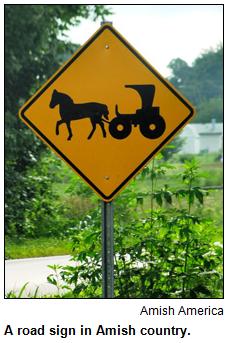 Only two states, Ohio and Pennsylvania, have larger Amish populations than Indiana.
Only two states, Ohio and Pennsylvania, have larger Amish populations than Indiana.
The 49,000 Amish residents here live in about 22 distinct communities scattered across the state, from Elkhart and LaGrange counties in northern Indiana to settlements near the towns of Washington in southern Indiana, as well as Berne and Geneva in the northeast.
"What is it about the Amish that both enchants and perplexes us? ... Could a horse-and-buggy people be more satisfied than the rest of us, with all our modern conveniences?"
Those questions are posed in a new book whose co-author, Steven Nolt, a history professor at Goshen College, will be Nelson's guest to explore all aspects of the "intensely private and insular" folks, who, as his latest book puts it, are "known for their simple clothing, plain lifestyle and limited technology."
Steve's co-authors of The Amish (Johns Hopkins University Press, 2013) are Donald Kraybill and Karen Johnston-Weiner. In addition, Steve is the author or co-author of several other books about the Amish and has collaborated on multiyear research projects about their religion, history and distinctive culture.
 We will explore aspects of the ever-increasing population of Amish (the average family has seven children), ranging from their values and schools to their shift from an almost exclusive focus on farming to jobs in factories and businesses such as the RV industry in the Elkhart area - even though the Amish do not own or drive motor vehicles.
We will explore aspects of the ever-increasing population of Amish (the average family has seven children), ranging from their values and schools to their shift from an almost exclusive focus on farming to jobs in factories and businesses such as the RV industry in the Elkhart area - even though the Amish do not own or drive motor vehicles.
According to The Amish, about two-thirds now support themselves in Amish-owned small businesses or by working in non-Amish factories and shops.
Steve also will address misconceptions about the Amish, who recently have become, as his book puts it, "popular culture icons of tourism and reality TV shows, even as they have deftly learned to flourish in a digital world."
He points out that the Amish are not homogeneous. Some communities in Indiana include families who send their children to public schools until the eighth grade; children in other communities almost exclusively attend private schools. 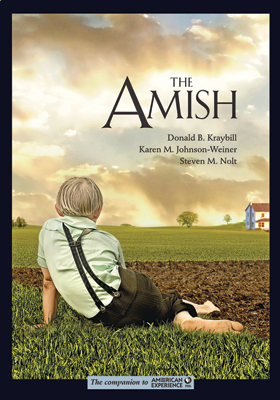 (In Adams County, our host Nelson recently was part of a group that visited a one-room Amish schoolhouse attended by students ranging from 6 to 15 years old, all instructed by a single, bearded teacher.)
(In Adams County, our host Nelson recently was part of a group that visited a one-room Amish schoolhouse attended by students ranging from 6 to 15 years old, all instructed by a single, bearded teacher.)
Founded more than 300 years ago in Europe as an offshoot of the Anabaptist Christians, the Amish Church faced persecution. The first Amish settled in Pennsylvania during the 1730s. According to The Amish, many families headed west - including to Ohio and Indiana - during the 1800s because of rising land prices in the eastern United States.
In northern Indiana, the towns of Nappanee and Shipshewana- both with Amish communities that date to the 19th century - have been popular in recent decades for tourists and shoppers intrigued by products such as quilts and baked goods. The Amish typically refer to outsiders as, simply, "the English."
Steve also is the co-author of Mennonites, Amish, and the American Civil War (Johns Hopkins University Press, 2007). That book documents how many Amish communities strived to remain pacifists and refused military service in the Civil War.
Voting patterns, though, often reflected those of their "English" neighbors. Amish in Holmes County, Ohio, which today has the country's largest concentration, tended to vote Democratic, the dominant political party in that region during the Civil War era. In LaGrange County, where the GOP dominated, Amish tended to vote Republican.
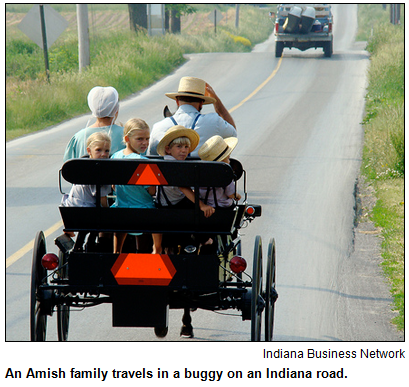 In The Amish, Steve and his co-authors explore Rumspringa (which translates as "running around"), the rite of passage when adventurous teenagers in many Amish communities enjoy the freedom to experiment with cultural influences before deciding whether to be baptized and officially join the church.
In The Amish, Steve and his co-authors explore Rumspringa (which translates as "running around"), the rite of passage when adventurous teenagers in many Amish communities enjoy the freedom to experiment with cultural influences before deciding whether to be baptized and officially join the church.
During our show, Steve and Nelson will explore misconceptions about Rumspringa, which drew widespread attention in the late 1990s following a series of alcohol and drug arrests of "wilding" Amish teenagers.
Typically, Rumspringa ends with marriage, according to The Amish. Activities during the rite of passage vary widely among Amish communities, with many youth never engaging in mischief.
"In other communities, some youth own cars, hit the party scene and give their parents anxious nights."
Other insights, courtesy of Steve Nolt and The Amish:
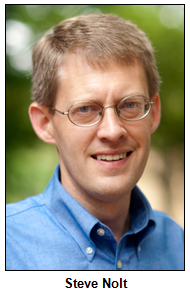 The U.S. Supreme Court in 1972 upheld the rights of Amish parents to end their children's education after the eighth grade. Before that, Amish families were prosecuted in some states.
The U.S. Supreme Court in 1972 upheld the rights of Amish parents to end their children's education after the eighth grade. Before that, Amish families were prosecuted in some states.- The Amish practice "shunning" to shame adult members who violate a community's beliefs. As with Rumspringa, the manner and severity of shunning (social avoidance) varies greatly among Amish groups. "Members may shake hands with offenders, but not accept anything - gifts, payments or money - directly from their hands," according to The Amish.
- About two-thirds of the Amish live in the northern part of the state, with LaGrange and Elkhart counties having the largest concentrations. Nearly 22,000 Amish people live in those two counties. The Amish population in Adams County is 7,200; in Daviess County in southern Indiana, it is 3,805.
- Overall, only about 14 percent of the Amish today are full-time farmers, according to some reports. In contrast, 61 percent were farmers in 1970. In addition to holding jobs in RV factories, many Amish in Indiana work in furniture-making and home construction.
Learn more: Watch the PBS documentary The Amish. Steve Nolt's new book is a companion to the PBS documentary, which is part of the American Experience series.
Roadtrip: Summit Lake State Park
Guest Roadtripper is Ken Marshall, an adjunct professor of communications and lifelong Indiana state park lover. He suggests we take the Roadtrip just a little north of New Castle to a hidden treasure, Summit Lake, which he says is never crowded.
The name "Summit Lake" comes from the fact that the area has the highest point of elevation in the immediate region. The area also has excellent fishing -and swimming, boating, hiking and camping - and it's also a great birding area.
Tune in on Saturday for more from Ken!
History Mystery
The Swiss heritage town of Berne in northeastern Indiana is located in Adams County, where some estimates indicate 12 percent of the population is Amish. In late July, Berne hosts a Swiss Days celebration that salutes its heritage. The town, which has about 4,000 residents, also includes Swiss Heritage Village, an outdoor museum.
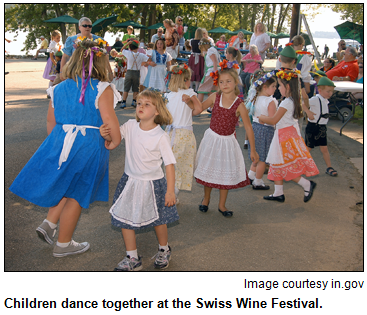 In another region of Indiana, a town on the Ohio River also has a Swiss-themed festival. The 42nd annual Swiss Wine Festival was held during late August in the town, which is celebrating its bicentennial this year. The wine festival is a salute to a Swiss immigrant family whose vineyard in the fertile soil near the Ohio River began in the early 1800s.
In another region of Indiana, a town on the Ohio River also has a Swiss-themed festival. The 42nd annual Swiss Wine Festival was held during late August in the town, which is celebrating its bicentennial this year. The wine festival is a salute to a Swiss immigrant family whose vineyard in the fertile soil near the Ohio River began in the early 1800s.
Question: What is the Ohio River town that celebrates a Swiss Wine Festival?
Hint: The town, and the county in which it's located, were the focus of a recent Hoosier History Live! show.
The call-in number is (317) 788-3314. Please do not call into the show until you hear Nelson pose the question on the air, and please do not try to win the prize if you have won any other prize on WICR during the last two months.
The prize is a gift certificate to the Hard Rock Café in downtown Indianapolis, two tickets to GlowGolf, a miniature golf course across from the food court at Circle Centre mall in Indianapolis, and admission for four to the Indiana Experience at the Indiana History Center, courtesy of Glow Golf and Visit Indy.
Your Hoosier History Live! team,
Nelson Price, host and creative director
Molly Head, producer, (317) 927-9101
Richard Sullivan, webmaster and tech director
Pam Fraizer, graphic designer
Garry Chilluffo, creative consultant
Michele Goodrich, Jed Duvall, grant consultants
Joan Hostetler, photo historian
Dana Waddell, volunteer-at-large
www.hoosierhistorylive.org






Please tell our sponsors that you appreciate their support: Indiana Authors Award | Indiana Historical Society | Lucas Oil | Re/Max Metro | Story Inn | The Fountain Square Theatre Building

 Acknowledgments to Print Resources, Monomedia, Indiana Humanities, Visit Indy, WICR-FM, Fraizer Designs, Heritage Photo & Research Services, Derrick Lowhorn and many other individuals and organizations. We are an independently produced program and are self-supporting through organizational sponsorships, grants and through individual tax-deductible contributions through Indiana Humanities. We do not receive any government funding. Visit our website to learn how you can support us financially. Also, see our Twitter feed and our Facebook page for regular updates.
Acknowledgments to Print Resources, Monomedia, Indiana Humanities, Visit Indy, WICR-FM, Fraizer Designs, Heritage Photo & Research Services, Derrick Lowhorn and many other individuals and organizations. We are an independently produced program and are self-supporting through organizational sponsorships, grants and through individual tax-deductible contributions through Indiana Humanities. We do not receive any government funding. Visit our website to learn how you can support us financially. Also, see our Twitter feed and our Facebook page for regular updates.
Oct. 12 show
Coliseum and Clowes Hall histories
The Coliseum at the Indiana State Fairgrounds - site of some of the most joyous and colorful events in Indy history, as well as some of the most tragic episodes - is undergoing a $63 million renovation.
Clowes Hall, which opened in 1963 at Butler University amid great uncertainty about its chances for success, is celebrating its 50th anniversary.
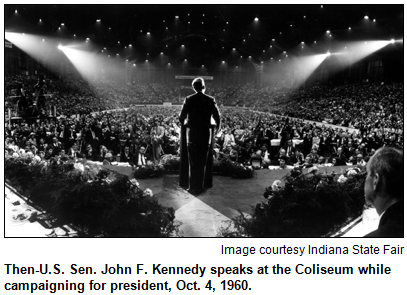 What better time to explore the histories of these two landmark venues?
What better time to explore the histories of these two landmark venues?
Chapters in their stories include concerts in 1964 by the Beatles; an explosion during an ice show on Halloween night in 1963 that remains among the most massive tragedies in state history; performances by household names ranging from Bob Hope, Judy Garland and Liberace to the Bolshoi, and public speakers including Coretta Scott King, Robert Kennedy Jr. and Indy native Kurt Vonnegut.
To explore the events, crises, celebrations and backstage stories that have unfolded at the Coliseum and Clowes, Nelson will be joined in studio by three guests. They are Justin Armstrong, director of advancement at the Indiana State Fair Foundation, James Cramer, community relations manager at Clowes, and Christine Thacker, the Clowes archivist.
The Coliseum, which opened in the fall of 1939, was constructed under Franklin D. Roosevelt's Public Works Administration. Its 11,000 seating capacity made the Coliseum the largest event facility in Indy then.
Three years later, the venue hosted its first basketball game, during which the Indiana High School All-Stars defeated the Kentucky High School All-Stars by one point. In 1967, the Coliseum became the home court of the Indiana Pacers, then playing in (and, eventually, three-time champions of) the American Basketball Association.
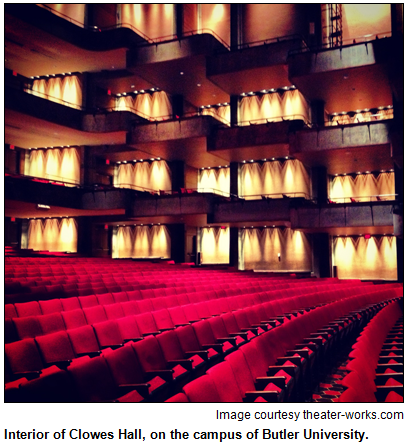 According to guests James and Christine, the opening of Clowes was a "huge gamble - they bet the farm." But the venue went on to host appearances by Barbra Streisand, Whitney Houston, John Travolta and other entertainers who either were (or became) icons.
According to guests James and Christine, the opening of Clowes was a "huge gamble - they bet the farm." But the venue went on to host appearances by Barbra Streisand, Whitney Houston, John Travolta and other entertainers who either were (or became) icons.
To celebrate the 50th anniversary of Clowes, artwork by Hoosiers will be displayed as part on an on-going "mosaic of visual art" throughout the 2013-14 season. The public is invited to a free open house and mosaic unveiling on Oct. 20 at 4 p.m. For more info about other 50th-anniversary festivities, visit cloweshall.org.
At the renovated Coliseum, which is scheduled to reopen next summer, the Art Deco exterior is being restored. The new interior will include double-tiered seating, a new video scoreboard and a modern sound system.
If the Coliseum endured wear and tear over the decades, it shouldn't be a shocker, given some of the events that were staged in the venue. In 1974, the Coliseum was the setting for the first - and largest - indoor tractor pull in the country.
History-show flashbacks:
- Longtime listeners of Hoosier History Live! will recall that we explored the 1963 Holiday on Ice explosion at the Coliseum during a show in October 2008 with Lawrence "Bo" Connor, a retired managing editor of The Indianapolis Star. He reported from the scene of the tragedy, during which 74 people were killed and about 400 more were injured.
- And during another show, we delved into the Beatles appearances with two guests who, as ardent teenage fans of the wildly popular "Fab Four," attended their 1964 concerts at the Coliseum. Both guests recalled they could not "hear a note of music" because of the screaming teens.
© 2013 Hoosier History Live! All rights reserved.